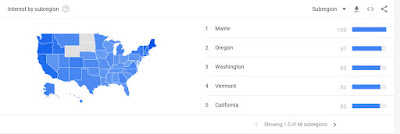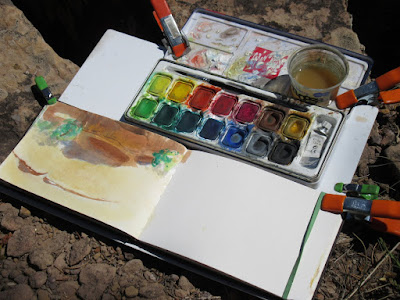 |
| Ghost Ranch Morning 9x12 Oil - Available |
Ghost Ranch and Abiqiui, New Mexico—Georgia O'Keeffe's old haunts. These are my old haunts, too, as I've visited and painted in the area many times over the last 20 years. This time, I spent three days there, painting in gouache and oil, and in reading Lesley Poling-Kempes' history of the property, Ghost Ranch.
 |
| The cottage O'Keeffe stayed in when first at Ghost Ranch. I doubt the handicap assist rails were there in her day. |
Base camp was our 1999 PleasureWay van, parked in a side canyon formed by a bent arm of red and grey hills. We were nestled right in the crook of the arm. From our post, we could see the blue anvil-head of the Pedernal. O'Keeffe once said, “It’s my private mountain. It belongs to me. God told me if I painted it enough, I could have it.” The mountain overlooks the entirety of the historic Piedra Lumbre Land Grant, a region of colorful hills, deep arroyos, and bright cliffs—“Piedra Lumbre” means “shining rock.” Ghost Ranch occupies 21,000 acres of this stunning and very paintable landscape.
Once a dude ranch, and before that, the legendary home of the Archuleta brothers, who were notorious cattle rustlers, it now belongs to the Presbyterian Church. The campus now offers many workshops and retreats, not just in spiritual matters, but also in the arts. But for painters, Ghost Ranch is best known for its connection to O'Keeffe. She started spending summers there as a guest in the 1930s. After her husband, Alfred Stieglitz, died, she bought a piece of the ranch and moved there permanently. Between her Ghost Ranch home and another house she owned in nearby Abiquiu, she spent the rest of her life—over forty years—painting the hills of the Piedra Lumbre.
 |
| The Ranch, with Chimney Rock illuminated by the morning sun. |
While reading Poling-Kempes' history, the characters that lived in this place were ever-present for me as I painted. I couldn't help but think of them crossing the landscape on foot or on horseback through the sagebrush, or of guests arriving via the Ranch's Lincoln touring car, a behemoth that could hold seven passengers plus luggage and still somehow lumber over the one-lane dirt road, down through arroyos and over rock-strewn hills, that wound for forty miles from the train depot in Española. And, of course, I imagined Georgia O'Keeffe, painting away at the foot of some particularly colorful hill that was cut by the rare rains into graceful curves.
 |
| Our trip wasn't all painting. We hiked, too. |
As some of you know, we had to cancel our Taos, New Mexico, painting retreat for this fall. But we are planning for next year—and as a bonus, we are going to schedule in some time for painting at Ghost Ranch. We'll spend a week in Taos, and then follow that with time at Ghost Ranch. The Taos retreat will start Sunday evening, September 26, 2021, and will run through Friday, October 1. Ghost Ranch, which won't officially be part of the retreat, will be that weekend. Let me know if you're interested, and I'll send you details as we get them. I hope you'll join us!
Here are some of the 5x8 gouache sketches from the trip:
 |
| View from the campground |
 |
| This was the preliminary sketch I did for "Ghost Ranch Morning". I sketched this the day before I did the oil version. |












